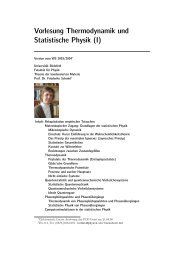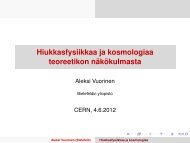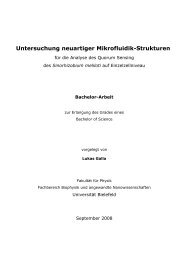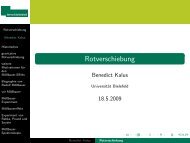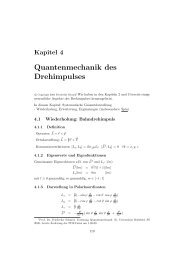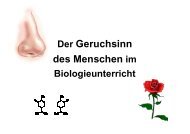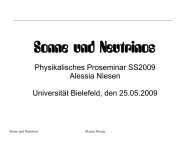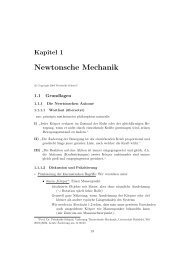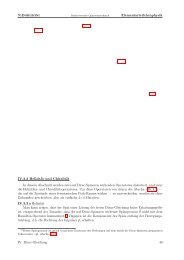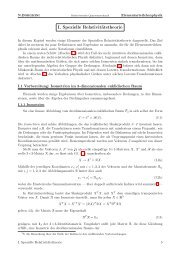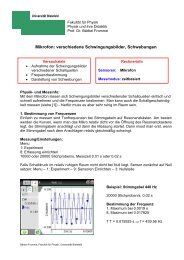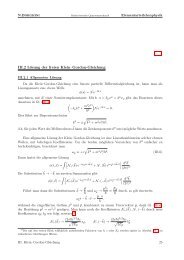De novo desmin-mutation N116S is associated with ... - ResearchGate
De novo desmin-mutation N116S is associated with ... - ResearchGate
De novo desmin-mutation N116S is associated with ... - ResearchGate
Create successful ePaper yourself
Turn your PDF publications into a flip-book with our unique Google optimized e-Paper software.
4604 Human Molecular Genetics, 2010, Vol. 19, No. 23<br />
(about 80%) were from the Heart and Diabetes Center North<br />
Rhine Westphalia (HDZ-NRW), Germany. Of these patients,<br />
22 were screened for all desmosomal genes causing ARVC<br />
and the gene DES, whereas patient #5 was screened only for<br />
<strong>mutation</strong>s in PKP2 and DES due to compliance problems.<br />
Patients were classified according to the rev<strong>is</strong>ed task force criteria<br />
for ARVC (38) (Table 1). In addition, ARVC diagnos<strong>is</strong><br />
of six patients who received HTx in our center was confirmed<br />
by pathological structural examination of the explanted heart,<br />
since we analysed a considerable number of index patients<br />
<strong>with</strong> terminal heart failure (Supplementary Material,<br />
Table S1). The carrier of the DES <strong>mutation</strong> was additionally<br />
examined for a myopathy by h<strong>is</strong>tology of a skeletal muscle<br />
biopsy from the M. quadriceps.<br />
All members included in the study were of Caucasian<br />
origin. Written informed consent was obtained from all participants.<br />
The study was approved by the local ethics committee.<br />
Mutation detection<br />
Blood samples were collected from the affected individuals<br />
and DNA was extracted from white blood cells using standard<br />
techniques (Illustra TM blood genomic Prep Mini Spin Kit, GE<br />
Healthcare, Buckinghamshire, UK). Mutation screening of<br />
five desmosomal genes was performed by direct sequencing.<br />
The <strong>desmin</strong> gene was screened by dHPLC.<br />
The genomic sequences used to design the primers were<br />
obtained from sequences in the GenBank database on the<br />
NCBI website (www.ncbi.nih.gov/projects/genome/guide/<br />
human). Based on the publ<strong>is</strong>hed sequence of plakophilin 2<br />
(NM_024422), plakoglobin (NM_004572), desmoplakin<br />
(NM_004415), desmocollin 2 (NM_024422), desmoglein 2<br />
(NM_001943) and <strong>desmin</strong> (NM_1927), amplification and<br />
sequencing of the exonic and adjacent intronic sequences<br />
were carried out following standard protocols. After amplification,<br />
PCR products were purified and labeled using the BigDye<br />
Terminator v3.1 cycle sequencing kit (Applied Biosystems,<br />
CA, USA) and sequenced in both directions on an ABI 310<br />
genetic analyzer. Sequencing electropherograms were<br />
inspected manually and analyzed <strong>with</strong> Variant Reporter Software<br />
v1.0 (Applied Biosystems).<br />
DES <strong>mutation</strong> screening was done by dHPLC using a<br />
DNASep column <strong>with</strong> a WAVE DNA Fragment Analys<strong>is</strong><br />
System (Transgenomic Inc., NE, USA) as described previously<br />
(35). The analytical temperatures for each exon are<br />
available from the authors upon request. Exons <strong>with</strong> aberrant,<br />
temperature-modulated heteroduplex profile were sequenced<br />
in both directions.<br />
For all <strong>mutation</strong>s, at least 640 chromosomes from ethnically<br />
matched, healthy individuals were genotyped using TaqMan<br />
SNP genotyping assay (Applied Biosystems) according to<br />
the manufacturer’s protocol.<br />
T<strong>is</strong>sue immunoh<strong>is</strong>tochem<strong>is</strong>try<br />
Immunofluorescence studies were performed on 5 mm thick<br />
frozen serial sections of left and RV heart muscle t<strong>is</strong>sue provided<br />
after HTx or of skeletal muscle t<strong>is</strong>sue (M. quadriceps),<br />
respectively. The following primary antibodies were used in<br />
th<strong>is</strong> study: (i) mouse monoclonal anti-<strong>desmin</strong> antibody D33<br />
(dilution 1:500; M0760, DakoCytomation, Germany) and (ii)<br />
mouse monoclonal anti-myotilin antibody (dilution 1:20;<br />
NCL-MYOTILIN, Leica Microsystems, UK). As secondary<br />
antibody sheep anti-mouse Ig biotinylated antibody<br />
(RPN1001, GE Healthcare Bio-Sciences AB, Sweden) in combination<br />
<strong>with</strong> Cy2-conjugated streptavidin (both dilution<br />
1:100) (016-220-084, Jackson ImmunoResearch, USA) was<br />
used. Immunostaining was performed according to the recommendations<br />
of the manufacturers. Staining was evaluated<br />
<strong>with</strong> a laser scanning spectral confocal microscope (Leica<br />
TCS SP2, Leica Microsystems, Germany).<br />
Cloning and mutagenes<strong>is</strong><br />
The full-length cDNA of <strong>desmin</strong> wild-type (<strong>De</strong>s WT) was<br />
amplified by polymerase chain reaction (PCR) using<br />
SC319574 vector DNA (human <strong>desmin</strong> cDNA in<br />
pCMV6-AC; OriGene, USA) as a template and complementary<br />
primers. The DES <strong>N116S</strong> (<strong>De</strong>s <strong>N116S</strong>) <strong>mutation</strong> was<br />
introduced by two-step PCR [overlap extension approach<br />
(49)], <strong>with</strong> the use of oligonucleotides containing the<br />
adenine-to-guanine transition at nucleotide position 347. For<br />
expression in E. coli BL21 (DE3) cells (Invitrogen, USA),<br />
amplified <strong>De</strong>s WT and <strong>N116S</strong> cDNA fragments were cloned<br />
into the bacterial T7 promoter expression vector pET100/<br />
D-TOPO (Invitrogen), which fuses a H<strong>is</strong>6 and Xpress<br />
epitope tag to the N-terminus of inserted fragments. For transfection<br />
of SW13 cells, both <strong>De</strong>s WT and <strong>N116S</strong> cDNA were<br />
cloned into the eukaryotic CMV promoter expression vector<br />
pLPCX (Clontech, USA) using pET100/D-<strong>De</strong>s WT or<br />
pET100/D-<strong>De</strong>s <strong>N116S</strong> as a template in addition to modified<br />
sequence-specific primers to generate a C-terminal ClaI<br />
restriction site during PCR. Fragments were cloned first into<br />
pCRII-TOPO (Invitrogen) followed by subcloning into<br />
pLPCX using EcoRI and ClaI restriction sites. The accuracy<br />
of all clones was controlled by sequencing.<br />
Protein expression and purification<br />
Recombinant protein expression in E. coli BL21 was induced<br />
according the recommendations of the manufacturers and verified<br />
by SDS–PAGE.<br />
Recombinant <strong>desmin</strong> WT and <strong>N116S</strong> proteins were <strong>is</strong>olated<br />
from inclusion bodies as described previously (50) <strong>with</strong> the<br />
modification that the pellet finally was d<strong>is</strong>solved in 8 M urea,<br />
10 mM Tr<strong>is</strong>–HCl (pH 8.0), 100 mM NaH2PO4, 15 mM<br />
b-mercaptoethanol. Purification under denaturing conditions<br />
via Ni-NTA affinity chromatography (Ni-NTA agarose;<br />
Qiagen, Germany) was performed according to the manufacturer’s<br />
instructions. For further purification, proteins were<br />
dialysed against the target buffer 8 M urea, 20 mM Tr<strong>is</strong>–HCl<br />
(pH 7.5) and 1 mM DTT and supplied to a HiTrap DEAE<br />
Sepharose Fast Flow column (GE Healthcare Bio-Sciences<br />
AB). Proteins were eluted by a linear salt gradient (0–<br />
0.3 mM NaCl). Fractions were analyzed by SDS–PAGE and<br />
those containing pure <strong>desmin</strong> WT or <strong>N116S</strong> were pooled.<br />
Protein concentrations were measured by the method of Bradford<br />
(51). As determined by anti-<strong>desmin</strong> immunoblot analys<strong>is</strong>,<br />
Downloaded from<br />
hmg.oxfordjournals.org at Universitaetbibliothek 003 on February 11, 2011



